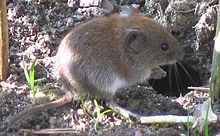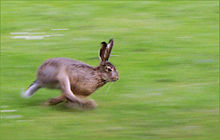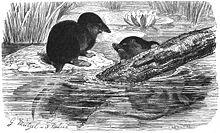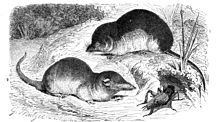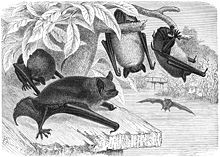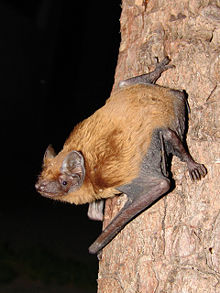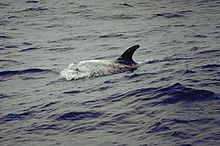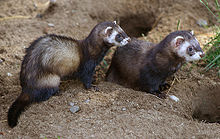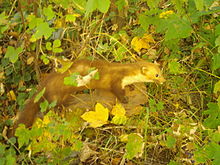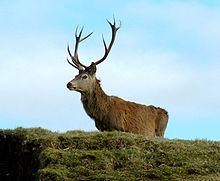- List of mammals of Denmark
-
This is a list of the mammal species recorded in Denmark. There are 56 mammal species in Denmark, of which 0 are critically endangered, 0 are endangered, 4 are vulnerable, and 2 are near-threatened.[1]
The following tags are used to highlight each species' conservation status as assessed by the IUCN:
EX Extinct No reasonable doubt that the last individual has died. EW Extinct in the wild Known only to survive in captivity or as a naturalized populations well outside its previous range. CR Critically Endangered The species is in imminent risk of extinction in the wild. EN Endangered The species is facing an extremely high risk of extinction in the wild. VU Vulnerable The species is facing a high risk of extinction in the wild. NT Near Threatened The species does not meet any of the criteria that would categorise it as risking extinction but it is likely to do so in the future. LC Least Concern There are no current identifiable risks to the species. DD Data Deficient There is inadequate information to make an assessment of the risks to this species. Some species were assessed using an earlier set of criteria. Species assessed using this system have the following instead of Near Threatened and Least Concern categories:
LR/cd Lower Risk/conservation dependent Species which were the focus of conservation programmes and may have moved into a higher risk category if that programme was discontinued. LR/nt Lower Risk/near threatened Species which are close to being classified as Vulnerable but are not the subject of conservation programmes. LR/lc Lower Risk/least concern Species for which there are no identifiable risks. Subclass: Theria
Infraclass: Eutheria
Order: Rodentia (rodents)
Rodents make up the largest order of mammals, with over 40 percent of mammalian species. They have two incisors in the upper and lower jaw which grow continually and must be keep short by gnawing. Most rodents are small though the capybara can weigh up to 45 kg (100 lb).
- Suborder: Sciurognathi
- Family: Sciuridae (squirrels)
- Subfamily: Sciurinae
- Tribe: Sciurini
- Genus: Sciurus
- Red Squirrel Sciurus vulgaris NT
- Genus: Sciurus
- Tribe: Sciurini
- Subfamily: Sciurinae
- Family: Gliridae (dormice)
- Subfamily: Leithiinae
- Genus: Muscardinus
- Hazel Dormouse Muscardinus avellanarius LR/nt
- Genus: Muscardinus
- Subfamily: Leithiinae
- Family: Dipodidae (jerboas)
- Subfamily: Sicistinae
- Genus: Sicista
- Northern Birch Mouse Sicista betulina LR/nt
- Genus: Sicista
- Subfamily: Sicistinae
- Family: Cricetidae
- Subfamily: Arvicolinae
- Genus: Arvicola
- Water Vole Arvicola terrestris LR/lc
- Genus: Clethrionomys
- Bank Vole Clethrionomys glareolus LR/lc
- Genus: Microtus
- Field Vole Microtus agrestis LR/lc
- Common Vole Microtus arvalis LR/lc
- Genus: Arvicola
- Subfamily: Arvicolinae
- Family: Muridae (mice, rats, voles, gerbils, hamsters, etc.)
- Subfamily: Murinae
- Genus: Apodemus
- Striped Field Mouse Apodemus agrarius LR/lc
- Wood mouse Apodemus sylvaticus LC
- Genus: Micromys
- Harvest Mouse Micromys minutus LR/nt
- Genus: Apodemus
- Subfamily: Murinae
- Family: Sciuridae (squirrels)
Order: Lagomorpha (lagomorphs)
The lagomorphs comprise two families, Leporidae (hares and rabbits), and Ochotonidae (pikas). Though they can resemble rodents, and were classified as a superfamily in that order until the early 20th century, they have since been considered a separate order. They differ from rodents in a number of physical characteristics, such as having four incisors in the upper jaw rather than two.
- Family: Leporidae (rabbits, hares)
- Genus: Oryctolagus
- European Rabbit Oryctolagus cuniculus LR/lc
- Genus: Lepus
- European Hare Lepus europaeus LR/lc
- Genus: Oryctolagus
Order: Erinaceomorpha (hedgehogs and gymnures)
The order Erinaceomorpha contains a single family, Erinaceidae, which comprise the hedgehogs and gymnures. The hedgehogs are easily recognised by their spines while gymnures look more like large rats.
- Family: Erinaceidae (hedgehogs)
- Subfamily: Erinaceinae
- Genus: Erinaceus
- West European Hedgehog Erinaceus europaeus LR/lc
- Genus: Erinaceus
- Subfamily: Erinaceinae
Order: Soricomorpha (shrews, moles, and soledons)
The "shrew-forms" are insectivorous mmmals. The shrews and soledons closely resemble mice while the moles are stout bodied burrowers.
- Family: Soricidae (shrews)
- Subfamily: Soricinae
- Tribe: Nectogalini
- Genus: Neomys
- Eurasian Water Shrew Neomys fodiens LR/lc
- Genus: Neomys
- Tribe: Soricini
- Genus: Sorex
- Common Shrew Sorex araneus LR/lc
- Eurasian Pygmy Shrew Sorex minutus LR/lc
- Genus: Sorex
- Tribe: Nectogalini
- Subfamily: Soricinae
- Family: Talpidae (moles)
- Subfamily: Talpinae
- Tribe: Talpini
- Genus: Talpa
- European Mole Talpa europaea LR/lc
- Genus: Talpa
- Tribe: Talpini
- Subfamily: Talpinae
Order: Chiroptera (bats)
The bats' most distinguishing feature is that their forelimbs are developed as wings, making them the only mammals in the world naturally capable of flight. Bat species account for about 20% of all mammals.
- Family: Vespertilionidae
- Subfamily: Myotinae
- Genus: Myotis
- Brandt's Bat Myotis brandti LR/lc
- Pond Bat Myotis dasycneme VU
- Daubenton's bat Myotis daubentonii LR/lc
- Whiskered bat Myotis mystacinus LR/lc
- Natterer's bat Myotis nattereri LR/lc
- Genus: Myotis
- Subfamily: Vespertilioninae
- Genus: Barbastella
- Barbastelle Barbastella barbastellus VU
- Genus: Eptesicus
- Serotine bat Eptesicus serotinus LR/lc
- Genus: Nyctalus
- Common Noctule Nyctalus noctula LR/lc
- Genus: Pipistrellus
- Common Pipistrelle Pipistrellus pipistrellus LC
- Genus: Plecotus
- Brown long-eared bat Plecotus auritus LR/lc
- Genus: Vespertilio
- Parti-coloured bat Vespertilio murinus LR/lc
- Genus: Barbastella
- Subfamily: Myotinae
- Family: Molossidae
- Genus: Tadarida
- European Free-tailed Bat Tadarida teniotis LR/lc
- Genus: Tadarida
Order: Cetacea (whales)
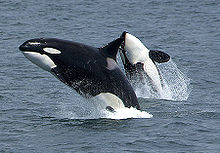 Killer whales jumping
Killer whales jumping
The order Cetacea includes whales, dolphins and porpoises. They are the mammals most fully adapted to aquatic life with a spindle-shaped nearly hairless body, protected by a thick layer of blubber, and forelimbs and tail modified to provide propulsion underwater.
- Suborder: Mysticeti
- Family: Balaenopteridae
- Subfamily: Balaenopterinae
- Genus: Balaenoptera
- Minke Whale Balaenoptera acutorostrata LR/nt
- Genus: Balaenoptera
- Subfamily: Balaenopterinae
- Family: Balaenopteridae
- Suborder: Odontoceti
- Superfamily: Platanistoidea
- Family: Monodontidae
- Genus: Delphinapterus
- Beluga Delphinapterus leucas VU
- Genus: Delphinapterus
- Family: Phocoenidae
- Genus: Phocoena
- Harbour Porpoise Phocoena phocoena VU
- Genus: Phocoena
- Family: Ziphidae
- Subfamily: Hyperoodontidae
- Genus: Mesoplodon
- Sowerby's Beaked Whale Mesoplodon bidens DD
- Genus: Mesoplodon
- Subfamily: Hyperoodontidae
- Family: Delphinidae (marine dolphins)
- Genus: Tursiops
- Bottlenose Dolphin Tursiops truncatus DD
- Genus: Delphinus
- Common dolphin Delphinus delphis LR/lc
- Genus: Lagenorhynchus
- Atlantic White-sided Dolphin Lagenorhynchus acutus LR/lc
- White-beaked Dolphin Lagenorhynchus albirostris LR/lc
- Genus: Grampus
- Risso's Dolphin Grampus griseus DD
- Genus: Pseudorca
- False Killer Whale Pseudorca crassidens LR/lc
- Genus: Orcinus
- Orca Orcinus orca LR/cd
- Genus: Globicephala
- Pilot whale Globicephala melas LR/lc
- Genus: Tursiops
- Family: Monodontidae
- Superfamily: Platanistoidea
Order: Carnivora (carnivorans)
There are over 260 species of carnivorans, the majority of which eat meat as their primary dietary item. They have a characteristic skull shape and dentition.
- Suborder: Caniformia
- Family: Canidae (dogs, foxes)
- Family: Ursidae (bears)
- Genus: Ursus
- Brown Bear Ursus arctos EX
- Genus: Ursus
- Family: Mustelidae (mustelids)
- Genus: Mustela
- Stoat Mustela erminea LR/lc
- Least Weasel Mustela nivalis LR/lc
- European Polecat Mustela putorius LR/lc
- Genus: Martes
- Beech Marten Martes foina LR/lc
- Pine Marten Martes martes LR/lc
- Genus: Meles
- Eurasian Badger Meles meles LR/lc
- Genus: Lutra
- European Otter Lutra lutra NT
- Genus: Mustela
- Family: Odobenidae
- Genus: Odobenus
- Walrus Odobenus rosmarus LR/lc
- Genus: Odobenus
- Family: Phocidae (earless seals)
- Genus: Cystophora
- Hooded Seal Cystophora cristata LR/lc
- Genus: Phoca
- Common Seal Phoca vitulina LR/lc
- Genus: Cystophora
Order: Artiodactyla (even-toed ungulates)
The even-toed ungulates are ungulates whose weight is borne about equally by the third and fourth toes, rather than mostly or entirely by the third as in perissodactyls. There are about 220 artiodactyl species, including many that are of great economic importance to humans.
- Family: Cervidae (deer)
- Subfamily: Cervinae
- Subfamily: Capreolinae
- Genus: Capreolus
- Roe Deer Capreolus capreolus LR/lc
- Genus: Capreolus
Notes
- ^ This list is derived from the IUCN Red List which lists species of mammals and includes those mammals that have recently been classified as extinct (since 1500 AD). The taxonomy and naming of the individual species is based on those used in existing Wikipedia articles as of 21 May 2007 and supplemented by the common names and taxonomy from the IUCN, Smithsonian Institute, or University of Michigan where no Wikipedia article was available.
References
- "The IUCN Red List of Threatened Species: Mammals of Denmark". IUCN. 2001. http://www.iucnredlist.org/search/search.php?kingname=ANIMALIA&phyname=CHORDATA&claname=MAMMALIA&freetext=&modifier=phrase&criteria=wholedb&taxa_species=1&redlistCategory%5B0%5D=all&redlistAssessyear%5B0%5D=all&country%5B0%5D=DK&aquatic%5B0%5D=all®ions%5B0%5D=all&habitats%5B0%5D=all&threats%5B0%5D=all&Submit_x=34&Submit_y=9&extendedResults=0&terrestrial=0&marine=0&freshwater=0&offset=0&sortorder%5B0%5D=spcscientificname&sortorder%5B1%5D=genname&sortorder%5B2%5D=spcname&sortorder%5B3%5D=spcauthor&sortorder%5B4%5D=spcinfrarank&sortorder%5B5%5D=spcinfraepithet&sortorder%5B6%5D=spcinfrarankauthor&sortorder%5B7%5D=spcstockname&sortorder%5B8%5D=comname_comp&sortorder%5B9%5D=rlcabb&sortorder%5B10%5D=rlscriteria&sortorder%5B11%5D=poptrend_code&sortorder%5B12%5D=rlcatcrit2001&sortorder%5B13%5D=spcrecid&sortorder%5B14%5D=kingname&debug=0&taxa_subspc=0&taxa_stock=0&newsort=Genus. Retrieved 22 May 2007.[dead link]
- "Mammal Species of the World". Smithsonian National Museum of Natural History. 2005. Archived from the original on 27 April 2007. http://web.archive.org/web/20070427043030/http://nmnhgoph.si.edu/msw/. Retrieved 22 May 2007.
- "Animal Diversity Web". University of Michigan Museum of Zoology. 1995-2006. http://animaldiversity.ummz.umich.edu/site/index.html. Retrieved 22 May 2007.
See also
- List of chordate orders
- List of regional mammals lists
- List of prehistoric mammals
- Mammal classification
- New mammal species
List of mammals of Europe Sovereign
states- Albania
- Andorra
- Armenia
- Austria
- Azerbaijan
- Belarus
- Belgium
- Bosnia and Herzegovina
- Bulgaria
- Croatia
- Cyprus
- Czech Republic
- Denmark
- Estonia
- Finland
- France
- Georgia
- Germany
- Greece
- Hungary
- Iceland
- Ireland
- Italy
- Kazakhstan
- Latvia
- Liechtenstein
- Lithuania
- Luxembourg
- Macedonia
- Malta
- Moldova
- Monaco
- Montenegro
- Netherlands
- Norway
- Poland
- Portugal
- Romania
- Russia
- San Marino
- Serbia
- Slovakia
- Slovenia
- Spain
- Sweden
- Switzerland
- Turkey
- Ukraine
- United Kingdom
- (England
- Northern Ireland
- Scotland
- Wales)
States with limited
recognition- Abkhazia
- Kosovo
- Nagorno-Karabakh
- Northern Cyprus
- South Ossetia
- Transnistria
Dependencies
and other territories- Åland
- Faroe Islands
- Gibraltar
- Guernsey
- Jan Mayen
- Jersey
- Isle of Man
- Svalbard
Other entities Categories:- Lists of mammals by location
- Denmark-related lists
- Mammals of Europe
- Suborder: Sciurognathi
Wikimedia Foundation. 2010.

